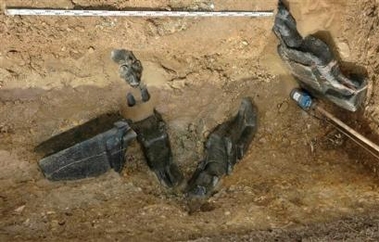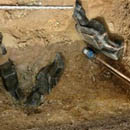Egyptian Temple Yields 17 Statues of Lion-Headed Goddess
National Geographic News
Sun March 12, 2006
Archaeologists working in Luxor, Egypt, have unearthed 17 statues of an ancient Egyptian goddess with the head of a lion and the body of a woman.
The Egyptian-German team made the discovery while doing restoration work at the temple of Pharaoh Amenhotep III on the Nile's west bank in southern Egypt.
Six additional statues of the goddess, called Sekhmet, had been found at the same site shortly before this latest discovery.
In ancient Egypt, Sekhmet was considered the goddess of both war and healing.
Why there are so many similar statues at the site remains a matter of speculation.
"The reason for this large number of Sekhmet statues may be that Amenhotep III was sick and put statues in the temple to heal him," said Zahi Hawass, head of Egypt's Supreme Council of Antiquities.
"Or possibly it was wartime, and [the statues were meant to] help the soldiers win and be healed."
Key of Life
Amenhotep III ruled from around 1390 to 1350 B.C.
He built extensively at the temple of Karnak, north of modern-day Luxor. Later in his reign he built another temple on the Nile's west bank in Luxor. (Read Geographic magazine's "Pharaohs of the Sun.")
This second complex is now in ruins with only two large statues representing Amenhotep remaining.
The current excavation first unearthed six black granite statues of Sekhmet near the courtyard of what was once the temple. The statues depict Sekhmet seated on a throne holding an ankh-the symbolic key of life-in her left hand.
The researchers found another 17 Sekhmet statues buried nearby. The statues are life-size and show the seated goddess wearing a crown. Inscriptions on the either side of each seat indicate the various names of Amenhotep.
"They were taken from the court of the temple and put underground, possibly to protect them from destruction," said Hawass, who is a National Geographic Society explorer-in-residence.
Cure Disease
In Egyptian mythology Sekhmet was a war goddess. She represented the fiery power of the sun. Part of her destructive side was disease and plague, but she was also believed to be able to cure diseases.
In order to placate Sekhmet, ancient priests performed a ritual before a different statue of her on each day of the year.
Amenhotep III probably had hundreds of Sekhmet statues created, and scores of them have been found in the temple of Karnak.
"This particular king is famous for having created a huge number of these statues," said Peter Brand, an Egyptologist at the University of Memphis in Tennessee.
But Brand is surprised that so many of the Sekhmet statues were discovered at the Luxor site.
One theory recently put forth suggests that the statues may have been moved to the west bank for a festival to honor the pharaoh.
"Perhaps [Amenhotep] had created all these statues of different gods and brought them to his temple for a celebration and then dispersed them to other temples, where most of them have been found," Brand said.
According to another theory, an epidemic of some plaguelike disease may have been ravaging the region, prompting Amenhotep to seek aid from Sekhmet.
"One possibility is that the king dedicated all the statues of this goddess in an effort to stave off the disease," Brand said.





 Share your thoughts in the Forum
Share your thoughts in the Forum
